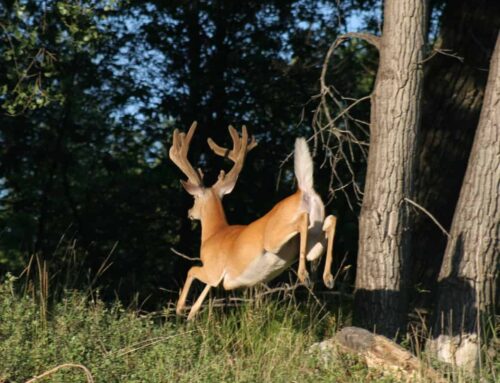 Every year you plan to scout like a wild man, but then come work deadlines, kids’ ball games, chores around the house… Sound familiar? If so, don’t worry that you won’t get your buck because you don’t have time to do your homework. Squeeze a little “speed scouting” into your schedule and you should do all right.
Every year you plan to scout like a wild man, but then come work deadlines, kids’ ball games, chores around the house… Sound familiar? If so, don’t worry that you won’t get your buck because you don’t have time to do your homework. Squeeze a little “speed scouting” into your schedule and you should do all right.
Whether you’ll hunt new ground or a familiar place. begin scouting from your den. Spend a couple of evenings studying topographical maps and aerial photographs, zeroing in on four “deer activity zones” (DAZ):
- Openings—crop fields, food plots, pastures, rights-of-way, clear-cuts or burns–where bucks feed and commingle with does.
- Security zones—large thickets, swamps, overgrown fields, etc.—where mature bucks go when the guns start booming.
- Linear creek or river bottoms, which should hold a good mix of food and cover for one or more family units of deer.
- Funnels—strips of woods, hollows, saddles and the like that whitetails travel between zones 1,2 and 3.
You can read maps and rule out up to 50 percent of marginal or likely unproductive deer country. Which means you can then spend your limited scouting time in the DAZ where you stand the best chance of killing a buck.
Take a day off work a week or so before the archery opener. Drive to a hunt zone around noon when most deer are bedded. Slip on rubber boots, spray your camo clothes with an odor-neutralizer and go for a power walk.
Hike the fringes of fields and other openings, checking for doe trails that wend back into the cover. Cruise into nearby creek bottoms and funnels, looking for freshly rubbed trees that start to pop up in September. Mature bucks blaze their core areas with big rubs that send sight and scent signals to does and other males.
Look for splayed, 3-inch tracks as you poke around field edges, creek crossings and other muddy areas. Big prints near big rubs pretty much seal the deal that you’re on to a good buck.
In the early season, you’ll likely find the freshest trails, tracks, rubs and droppings near hot food sources. You might also find early scrapes that tell you a buck or two are visiting a feeding area.
While it’s not smart to bust through major security areas where lots of deer rest, you should check out any “satellite” thickets you run across. Brier pockets, grassy ditches, honeysuckle tangles on ridges… When the season opens, these little covers are fine places to find big bucks staging near food sources, prowling for does and escaping hunting pressure.
Make a couple of sweeps through the DAZ, reading sign and looking for good spots for ground blinds or tree stands (go ahead and hang a stand or two if you like). Come back a second or third day if you need to, but be careful. A big benefit of speed scouting is that you don’t continuously stomp around the woods and spook deer.





